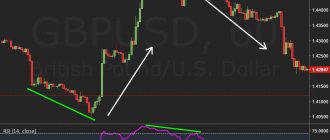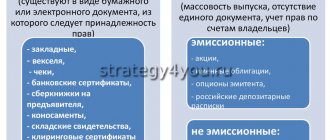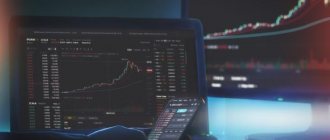Where to start making money on arbitrage between exchanges and instruments - the essence of arbitrage trading and transactions, types and examples of strategies.
The essence of arbitrage is to obtain risk-free/almost risk-free profit. In classical trading, a trader predicts the behavior of an asset and, in accordance with this, opens long or short positions. Arbitrage strategies, unlike the classical approach, are aimed at making a profit regardless of the direction of the chart movement.
Arbitrage on the stock exchange can generate income, but it is a very specific trading tactic and will not suit all traders without exception. Below is a detailed explanation of this technique and an overview of its varieties.
Types of arbitration
Classic arbitrage is the exploitation of quotation inefficiencies. Such arbitrage is quite rightly called spatial, because its existence is a consequence of the non-zero distance between the sources of quotes.
This formulation is equally relevant for grandmothers in the market, as well as for the stock exchange and high-frequency trading. No matter how fast communication channels are, we are still not able to transmit information faster than the speed of light. This means that a non-zero delay will always exist between two distant sites; only the tools for trading such arbitrage will change.
Bipedal arbitration . Typically this refers to arbitrage between two exchanges. The difference in prices between the two sites allows you to buy cheaper and sell more expensive the same instrument.
A classic example is buying and selling EURUSD from two different dealers. What we are actually doing is buying or selling the EURUSD spread.
In theory, the equity of such a position will be zero. But the real market is always in motion, and given the overhead costs (spread + commission) and different sources of quotes, the equity of such a position will fluctuate at some distance below zero (breakeven level). That is, if you try to buy and sell EURUSD now, most likely you will see an immediate minus in the amount of the double spread on your account.
Arbitrage is a situation when equity moves into a profitable zone. That is, we can say that we made money without risk by simultaneously buying and selling the same instrument.
The formation of such arbitrage is explained by the true decentralization of the exchange. When there is no single place to aggregate quotes, a situation can always arise where the buyer offers a higher price than the seller wants.
It is important to note that when trading such arbitrage, the direction of movement of rates does not matter to us. By buying the first and selling another instrument, we make money by changing their spread (difference). That is, in fact, the instrument may become more expensive on both exchanges, but you will still remain in the black if the price difference has decreased.
You can exit positions either when a certain profit is achieved, or reverse positions when the opposite condition appears. That is, when reverse arbitrage occurs, buyers and sellers will switch places.
Spatial arbitrage became widespread at the dawn of Forex. The main reason for the large discrepancies in quotes is the weak centralization of the market itself, the emergence of a large number of small market makers and the lack of high-quality aggregation.
Most often, the formation of such arbitrage was due to a significant lag in quotes from one of the dealers. Some traders are still trying to trade using this strategy with newly formed firms, whose quotation system may still contain errors, but obviously the golden age of such a strategy has already passed.
Now, when most of the processes are standardized, and liquidity providers are combined into a single stream of quotes through large aggregators, it is almost impossible for an ordinary trader to find and trade such a discrepancy.
One-legged arbitration . In fact, opening positions on different exchanges at the same time is not a requirement. If you have the opportunity to determine the “leading” market, then to trade arbitrage it is enough to open a trade on only one platform.
For example, we determined that broker A's quotes lag behind broker B's by a few seconds. At the same time, the price of broker B is currently 10 points higher. In this case, we enter a buy position through broker A, having a clear idea of where the price will go. From the technical side, this is much easier, but arbitration situations themselves appear much less frequently. Another disadvantage is the lack of market neutrality, which imposes additional risks and goes beyond the scope of classical arbitrage.
Synthetic Arbitration.
Let's say you wanted to trade the spread of the EURUSD pair. Thus, you can buy “real” EURUSD, hedging it with synthetics, selling EURGBP and GBPUSD. If you remove the names of the instruments, you are unlikely to ever distinguish the synthetic EURUSD from its real counterpart. However, the existing differences in quotes may be enough to create arbitrage, the trading of which is a matter of technique.
This type of arbitration is also called triangular. In this example, we have 100,000 euros on hand. With these funds we buy pounds, then with pounds we buy dollars, and then with dollars we buy euros again. Provided there is a small discrepancy in rates, we have a chance to get a guaranteed profit.
Please note that on liquid instruments, the profit from such arbitrage operations does not cover overhead costs in the form of spreads and commissions. In a properly functioning system, classical arbitrage is extremely difficult to trade, since almost all risk-free profit is leveled out by the market itself even before you. An ordinary trader without a direct connection to the exchange, large capital and specific knowledge has nothing to gain here.
Long-term arbitration.
However, if you are satisfied with small returns, there is a completely workable way to trade arbitrage over a long period of time. We are, of course, talking about the discrepancy between the futures price and the underlying instrument. In general, the strategy is similar to two-legged arbitrage - when the spread between two instruments increases, we buy their spread and wait for expiration.
For classical arbitrage, the quality of execution, as well as the availability of low commissions and spreads, are critical. All this must be taken into account before entering the market as potential risks.
In the case of long-term arbitrage, the quality of execution is not so important, provided that limit orders are used. But you need to take into account that an arbitrage situation can arise within one market tick. Therefore, automation cannot be done here. The profitability of such trading is unlikely to impress anyone, although there is a good chance of earning more than the bank interest rate.
Scheme No. 3. Intra-exchange triangle
Sometimes arbitrage opportunities arise within the trading platform itself. For example, when there is a divergence in the quotes of several cryptocurrencies. This arbitrage scheme is called intra-exchange or triangular.
Schematically it looks like this:
Arbitration on cryptocurrencies “Intra-exchange triangle”
As a result of such an arbitrage scheme, the profit will be 8235 – 8000 = 235 dollars, excluding commissions that the exchange charges for trading operations.
The second name of the scheme – triangular – is conditional, since there can be more than three assets in the chain.
The disadvantage of intra-exchange or triangular arbitrage is the risk that during the selection of the optimal chain of cryptocurrencies, their quotes may change. To minimize it, traders use unique cryptocurrency trading robots.
In turn, on some cryptocurrency platforms there are special delays for such orders, which may negatively affect the profits from such arbitrage.
Main advantages
To determine the presence of arbitrage, you do not need to study the history of quotes. The current flow of quotes is enough to see inefficiency and have time to trade it. Since arbitrage theory exploits market inefficiencies, the nature of quotes is also not important to us.
In general, trading classical arbitrage does not require any knowledge of technical or fundamental analysis. Although during an unstable market (for example, news releases), there are certainly more arbitrage situations.
From a trader’s point of view, this is an almost ideal trading system:
- You don’t need to worry about the state of open positions, news and price gaps;
- After a successful entry, profit is almost guaranteed;
- No complex analysis of historical quotes is required;
- The risk of failure is minimal and most often results from a technical glitch or poor execution.
Overview of the advisor's capabilities
Let’s say that three currencies are entered in the Currencies field of the Forex arbitrage advisor: EUR, USD and GBP. The robot will take them and create three obvious combinations: EUR/USD, EUR/GBP and GBP/USD. He will then compare prices to identify enough discrepancy to create an arbitrage situation. Having found this out, let us now consider the main stages of the work.
Preparation and analysis of information
It makes no sense to take on every arbitrage opportunity that arises for several reasons:
- it is difficult to keep track of the large number of held transactions;
- Sometimes several positions are opened with one asset, and this worsens the execution conditions, leads to increased costs and results in a loss.
Therefore, the trader first collects data that will help him identify the most profitable triangles, and then focuses exclusively on them.
Before you start collecting, carefully select the broker with whom the work takes place. If desired, they even test more than one company at a time, but just do not forget that the search for arbitrage situations should be carried out on a real account.
When starting to collect statistics, indicate in the Currencies field the currencies from which the advisor will create synthetic pairs for arbitration. In addition, it is important to fill out the MinPips field correctly. Here it is optimal to enter at least 3 points or more, since smaller values should not even be considered due to slippages that will not allow you to get such a small profit. Having entered the necessary data, set the “Monitoring” parameter to “True”, and the script begins analysis.
All interesting opportunities that the Forex arbitrage advisor finds during the research process will be recorded in a file called “Arbitrage”. Its location is in the “Files” folder inside the “MQL4” directory.
Opening this file after collecting data, the trader will see the following:
- time of occurrence of the situation;
- calculation formula;
- Bid/Ask quotes;
- the size of the discrepancy found.
Processing of received information
Having collected the data, the robot, in addition to the “Arbitrage” file, creates another one called “Arbitrage Statistic”, where information is entered on arbitration formulas (patterns), which the script sorts by the number of occurrences.
The easiest way for a trader is to look into this file and use the patterns that are located at the very top, that is, they occur more often than others. However, it is advisable to spend a little more time and see if the found situations for arbitrage appeared at the time the news came out. If yes, then it is better to skip them, since in real market conditions you will not be able to make a good entry when the news is published due to slippage.
Main problems
The main problem is that in a highly liquid market (for example, FOREX), such inefficiencies have either already been traded by someone else, or are almost completely eliminated by the presence of a high-speed communication channel.
On the other hand, low-liquidity instruments impose their own limitations. This may include partial or simply long execution, slippage and, in general, everything related to the process of order execution. In particular, this becomes a problem when the existence of an arbitrage situation is limited to a very short period of time.
As a result, it turns out that arbitrage, which is the most accessible to an ordinary trader, cannot provide high returns, and the most delicious market inefficiencies are eaten up by large players.
Disadvantages of common trading systems
Today, using arbitration on Forex is extremely risky, since the conditions for its occurrence have been practically destroyed by the introduction of ultra-high-speed communications, and on highly liquid instruments, market makers themselves use the described techniques, thereby preventing ordinary traders from successfully using them.
If you apply Forex arbitrage to low-liquidity assets, then the risk increases here, since it is difficult to achieve perfect execution without slippage and large spreads or commissions. Imperfections in the technical part cause the most problems when a deal needs to be opened and closed quickly.
The Dawn of Cryptocurrency
There is no clear leader in the cryptocurrency market and the main volumes are divided between dozens of different exchanges. Moreover, if the main turnover of Bitcoin occurs on one exchange, the peak turnover of Ethereum, for example, may occur on a completely different exchange. In general, we can say that the cryptocurrency market is now much more decentralized than Forex.
The green zone in the picture shows the current arbitrage between cryptocurrency exchanges using BTCUSD as an example. This means that in the cryptocurrency market there is real arbitrage between sites - you can buy currency in one place cheaper and sell it in another place for more. On liquid Forex instruments, such a situation is very rare, and the reason for this is the desire for centralization.
Naturally, in reality, everything is a little more complicated, and trading such arbitrage requires taking into account transaction costs. But even more interesting is the arbitrage between cryptocurrencies and traditional currency instruments. Some brokers already trade cryptocurrencies on a par with traditional FX instruments. This allows you to find arbitrage situations without going beyond one site.
In general, cryptocurrencies are suitable for various types of strategies that have become obsolete on popular currency pairs. Arbitration was and remains the most attractive strategy in terms of risk-to-reward ratio. The daily trading turnover of cryptocurrencies is estimated in billions. This is a large, actively developing market, and if you look for arbitrage within the Forex market, then only there.
Finding a suitable exchange
The number of cryptocurrency exchanges included in the monitoring lists is approaching 300 positions. However, you will have to spend time to select acceptable sites from this quantity.
Liquidity
Most importantly, the crypto exchange must have a high turnover. There is no value in a supposedly favorable quote if the order hangs in the glass for hours. Therefore, the choice can be limited by the Coinmarket rating based on an assessment consisting of a combination of various parameters (liquidity, traffic, real volume):
The 100 largest include YoBit and Exmo, popular among Russian traders. Read more about these exchanges in our articles:
- EXMO exchange review
- YoBit Exchange Review
Commissions
All commissions for input/output and trading operations must be taken into account. The most expensive fees are for processing fiat transfers. As a matter of fact, there are practically no ways to perform inter-exchange arbitrage with crypto-fiat pairs.
Even exchange codes (for example, Eksmo) will not make the operation profitable, since the exchange rate is approximately 5% lower than the exchange rate. Therefore, you should create a summary table with commissions for further analysis. Usually, it is profitable to make transfers in Dagcoins, Ripple, and most coins not from the TOP-30. Indicative table:
| Currency | Input, % | Conclusion, % | |
| Exmo | RUB USD EUR BTC XRP | 3.49 1,99-3,99 2,99 0 0 | 0.49-1.99 3.99 1 EUR 0.0004 0.02 |
| YoBit | RUB USD EUR BTC XRP | 0 0 — 0 0 | 2-5 1-7 — 0,0012 0,5 |
Number of crypto pairs
What is important is not the mathematical quantity, but a reasonable variety of pairs, which include coins from the TOP-100, and duplicate crypto pairs between different platforms for inter-exchange arbitrage.
You should avoid currencies with small capitalization , which is visible even visually:
With small capitalization and trading volumes, traps :
- sharp unfavorable change in quotes;
- impossibility of selling an asset because there are no sellers/buyers.
It is necessary not only to outline a scheme, but also to test it on small amounts in order to evaluate how the idea works without inter-exchange transfer.
Robot installation
Trade-Arbitrage robot script completely takes on the task of searching for arbitrage situations within one broker (platform). First, the robot takes all the currencies specified in the Currencies parameter,
and tries to collect real currency pairs from them.
The robot is not written in a very standard way and works like a looping script
, that is, it remains on the chart and is not deleted on its own. Typically, scripts are removed from the chart after executing a function. In this case, you can only remove the script from the chart manually through the context menu.
Therefore, the robot file “Trade-Arbitrage.mq4” needs to be moved not to MQL4 Experts, but to MQL4 Scripts
. To do this, in the terminal, go to File – Open data directory.
Next, select MQL4, Scripts and move the robot files here. After this, restart the terminal.
To run, simply drag the script onto the chart.
Also, don't forget to enable automated trading.
Programs and services
Manually monitoring exchanges is ineffective. For this purpose, programs have been created - scanners and robots. The former process and display information on the screen, the latter are configured to independently conduct deals and transactions.
Scanners
Since scanners do not conduct transactions, but only register opportunities, further actions must be carried out either manually or using additional software.
Spread scanner for inter-exchange arbitrage
Assistant program for scanning prices on 37 major cryptocurrency exchanges, including:
- Binance;
- Huobi;
- Kraken;
- Bitfinex;
- and others.
Website: https://daytradingschool.ru
The cost of the inter-exchange analysis scanbot for January 2021 is 24,500 rubles.
CryptoShock.org
Inter-exchange arbitrage scanner, demonstrates the results in the fxsa.org/threads/8290/ thread.
Bots
There is another category of market participants who trust the process to robots. In addition to arbitrage ones, there are robots with settings for classic trading, paid ones - Cryptotrader, Tradewave, BTC Robot and free ones , for example, Gekko.
Bitsgap
Platform with automated bots, signals and trading on exchanges through a single interface. The arbitrage function between exchanges is available on the advanced tariff for $44 per month.
Supported exchanges:
Link: https://bitsgap.com
Cryptohopper
Service with trading tools, triggers and bots for automatic trading. Arbitration is available on plans starting from $49 per month.
List of supported exchanges:
Link: https://www.cryptohopper.com
HAAS bot
A program with numerous settings, focused on trading. However, it includes the ability to arbitrage trades from three crypto pairs within one exchange.
The HTS 3.0 Interfac internal bot app is recommended for use in high-volume sites.
However, the developers concluded that the robot shows the best results when interest in trading is low, as was the case in the second and third quarters of 2021.
Now, when order books are tightly filled, competition is high and quotes are quickly leveling out, the assistant earns very modest amounts. At a minimum, you should choose exchanges with zero or very low commissions.
Address: https://www.haasonline.com/trade-bots/.
Zenbot
One of the most advanced bots. Artificial intelligence technologies are used to develop and support it. The program is capable of performing multi-transactions, trading using high-frequency strategies and concluding arbitrage transactions. The source code is open source, available at https://github.com/DeviaVir/zenbot.
Some users claim that they received income of up to 1.5 thousand% per quarter.
ApiTrade
A platform for connecting API keys of the most popular exchanges with the ability to configure trading strategies and inter-exchange arbitrage according to the Mirror scheme . The service takes 50% of the profit, suitable for beginners who have no experience with separate software. For arbitrage, it is necessary to select cryptocurrencies with fast, cheap transactions. Official website: https://apitrade.pro.
Read more about bots in the article: Trading bots for crypto exchanges - review of desktop and web versions.
Services for comparison
There are also special sites and software for comparing cryptocurrency quotes. In general, their value is questionable (updates every 5-10 minutes or less), so you shouldn’t completely trust them with all the analytical work:
- Bitcoinity - comparison of Bitcoin quotes.
- Bitinfocharts - comparison of quotes for different cryptocurrencies.
- Cryptowat - correlation and other data, the ability to create a portfolio.
- Bittrex/Yobit Exchange Tool is a free program for finding profitable trading pairs on the Bittrex and Yobit exchanges with the option to purchase a Pro version.
- zTrader is a trading platform for Android.
- TabTrader is a terminal for a smartphone.
Description of settings
- Currencies – list of currencies for generating synthetic pairs. The more currencies, the more potential arbitrage opportunities, but try not to list non-tradable instruments here;
- MinPips – min. difference (4 digits) between bid and ask prices for arbitrage trading;
- SlipPage – restrictions on price sliding when opening an order;
- Lock – prohibition on creating a lock;
- Lots – position volume for the generated synthetic;
- MaxLot – maximum position volume for a real instrument;
- MinLot – minimum volume for a real instrument;
- Monitoring – enables or disables recording of log files of detected arbitration. Please note that during real trading it is better to disable this function, since reading and writing a large number of files to disk may introduce additional delay;
- TimeToWrite – frequency of writing to a file (in minutes).
Minimizing risks
- After selecting sites, you need to verify your account where required. Otherwise, the first withdrawal may be blocked for weeks.
- It is necessary to monitor commissions, since on some exchanges the deposit/withdrawal deductions are dynamic and change frequently (Yobit and Eksmo).
- You should find out in practice how quickly the deposit is credited. Some exchanges claim a window of 20-30 minutes. Therefore, even lightning-fast Ripple will not appear on your account soon.
- What liquidity is can be learned by submitting small market and limit orders to the book. Having identified the trading volume of a crypto pair that suits you with the speed and accuracy of execution, you should focus on these figures when choosing additional sites. Volume is usually broadcast in Bitcoin.
- To conduct transactions, traders draw up tables where they indicate the cost of lines. After this, it becomes clear what mandatory costs accompany each transaction. 5% for inter-exchange transactions , but not less than 2% - if there are no commissions and cryptocoin transactions are cheap.
- It is useful to take into account the opening time of Forex sessions, since traders of fiat instruments are increasingly looking at crypto exchanges - during the opening hours of Forex trading, especially with the opening of the US, the market is active and there are more arbitrage opportunities.
- To trade pairs with Bitcoin at a rate of 10 thousand US dollars per 1 BTC, you need a starting capital of 1.5 thousand USD.
- In one transaction, in order to preserve capital, you need to send about 10% - when the minimum investment threshold has been passed.
In addition to the above rules, you must take risks seriously when setting up robots. After all, quite often a beginner starts with arbitrage, quickly switches to trading transactions, removes stops, sends capital to one instrument and suffers crushing losses.
How to work with the help of an advisor
To start trading using a Forex arbitrage advisor, you need to select the best patterns. After this, open the MQL4 folder and the Files directory contained inside. The next step is to edit the “Trade-Arbitrage” file, where the formulas of the selected patterns are entered. After this, the script is added again to the chart so that it restarts and updates the connection with the edited file.
At the time of adding, set the Monitoring parameter to false, and also indicate the money management data, according to which the adviser will open positions. After launch, the robot will wait for suitable situations and open a combination of orders that form a hedge based on several currency pairs and close them under certain conditions with a profit.
To make the necessary changes to the advisor, you should first understand its settings.











